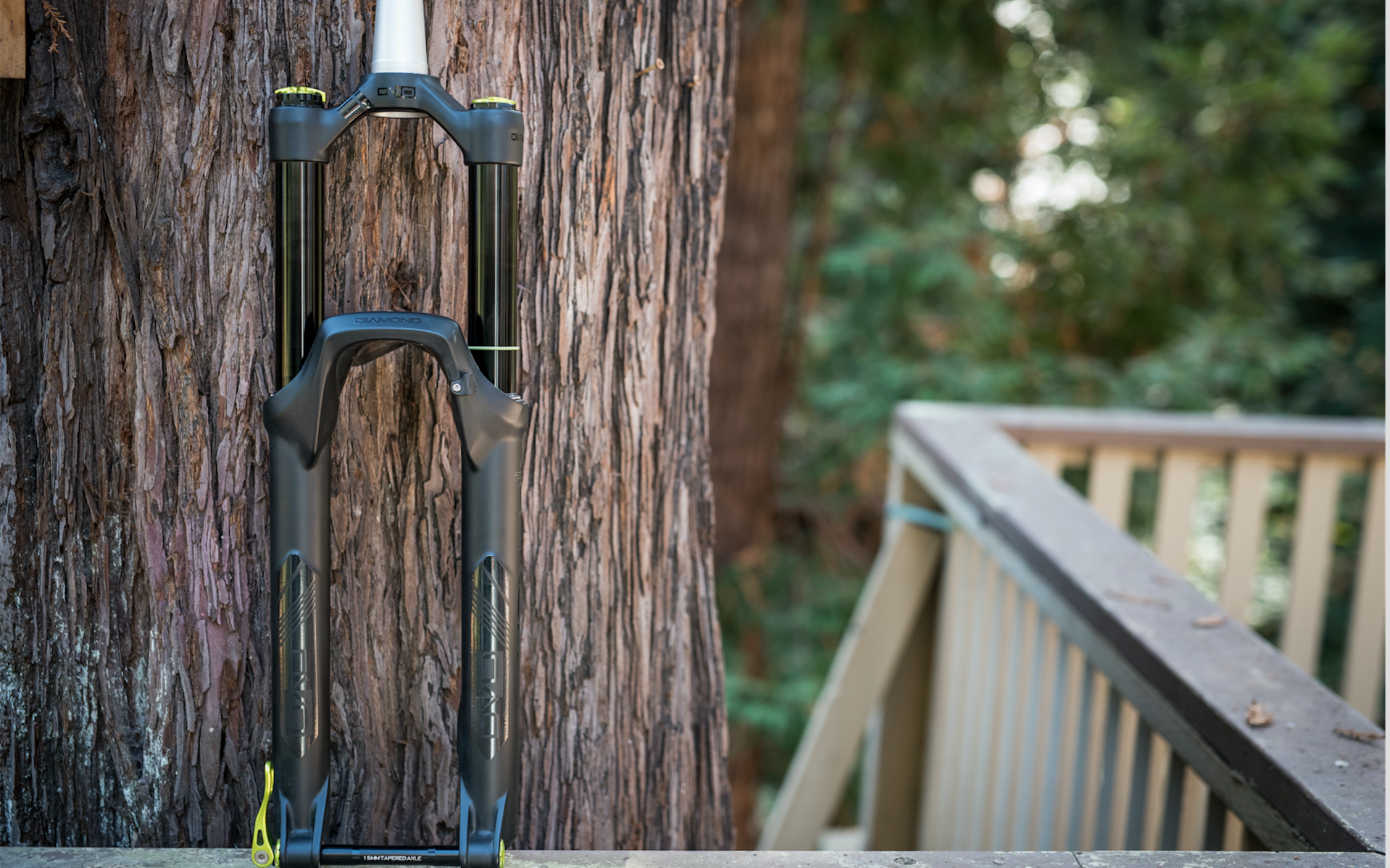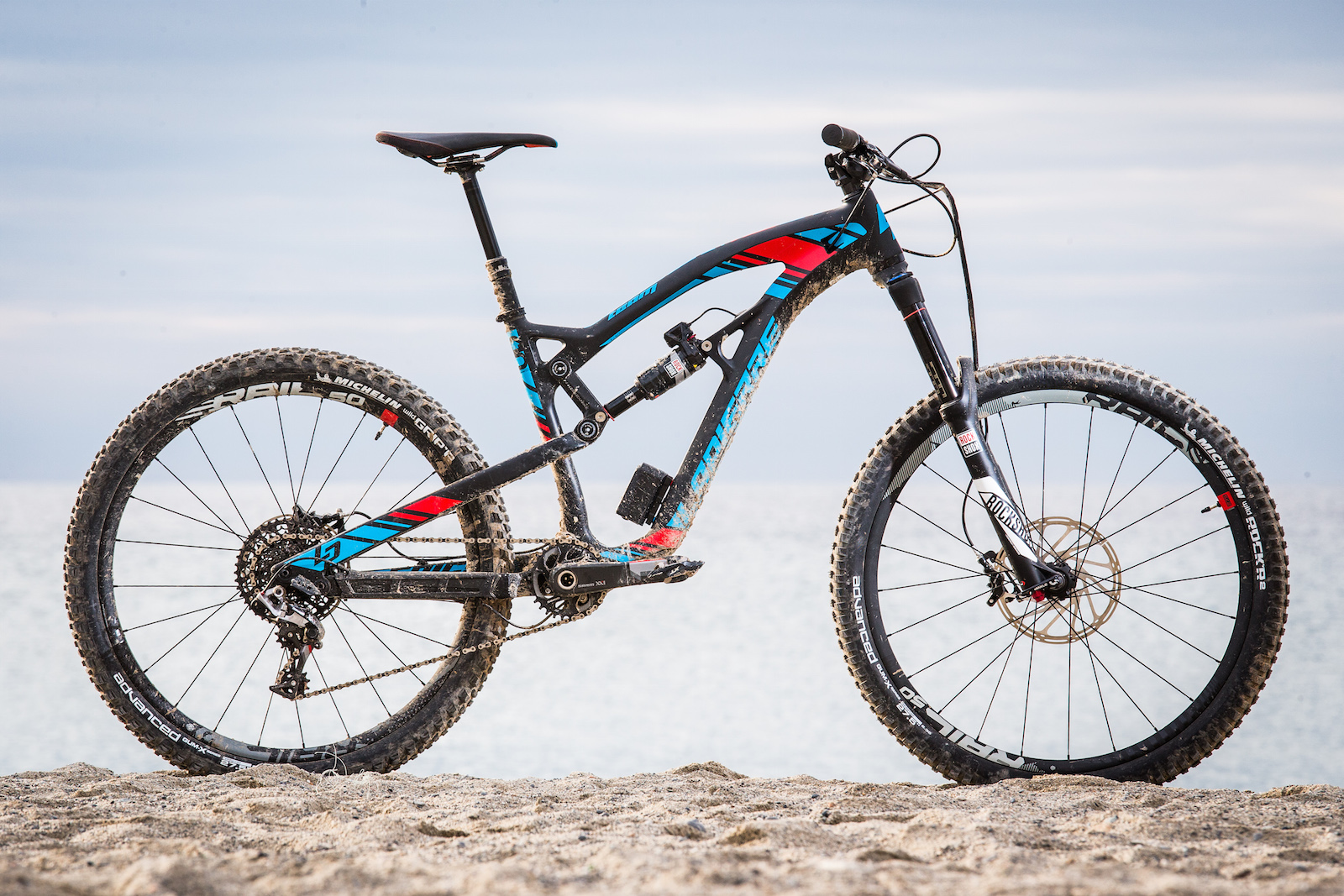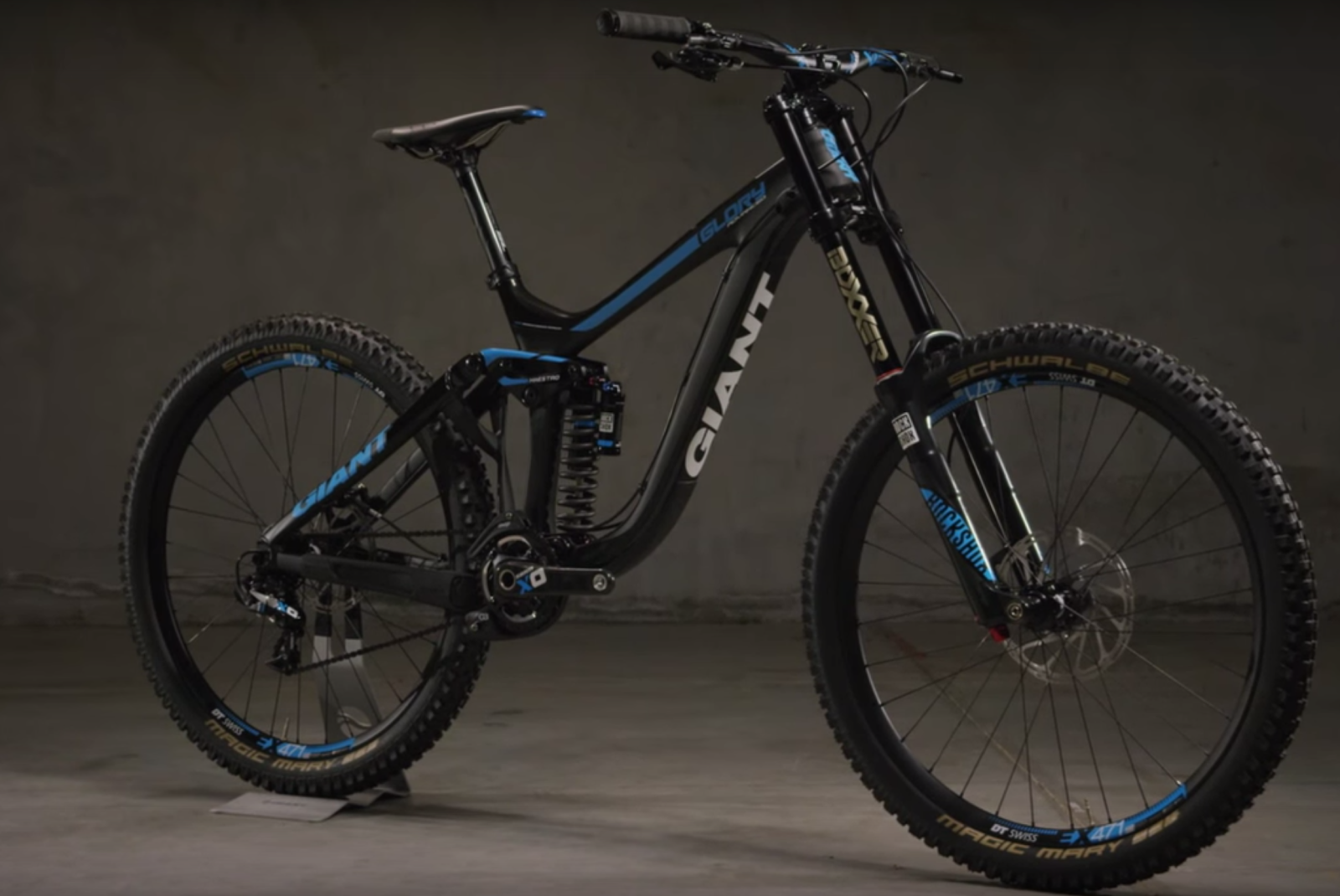[ad3]DVO first became a player in the MTB suspension game a couple years ago when they launched the Emerald; a wildly different take on the modern DH fork. With a few bold features and simple custom tuning options for the user, it quickly caught everyones attention. More recently however, DVO has jumped into the mid travel sector and launched the Diamond. Aimed staunchly at enduro, it was developed with a heavy influence from seasoned veteran/legend Cedric Gracia. Much like the Emerald, the Diamond is very unique and offers a few options that aren’t available from its competitors. We first sank our teeth into Diamond back in February aboard a pre production version and after a few months, DVO graciously swapped our fork out for an off the shelf version. Before we get into the nitty gritty of the review, we’ll highlight some specs and features that we will explain in more detail shortly.
Features
Quick range low speed compression (6 clicks external)
High speed compression adjust (24 clicks external)
OTT “Off The Top” negative spring adjust (external via 5mm allen key)
Closed cartridge bladder system
Integrated Fender
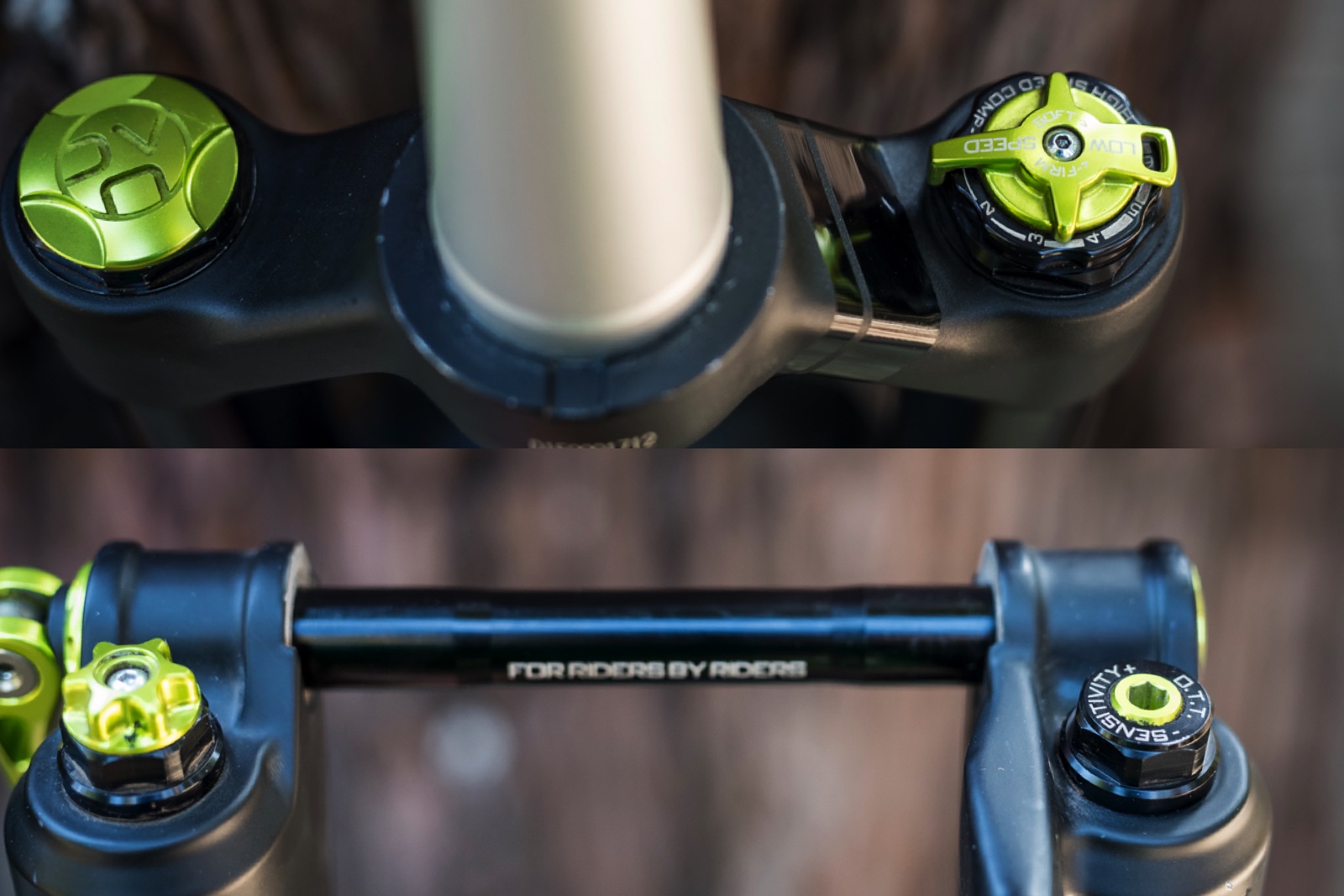
Specs
Travel : 140mm, 150mm, 160mm adjustable travel via internal spacers.
Crown : Forged CNC Hollow: 27.5 = 44mm Offset / 29″ = 51mm”
Axle to Crown : 27.5″ : 160mm=555mm / 150mm=545mm / 140mm=535mm
29″ : 160=572mm / 150mm=562mm / 140mm=552mm
Stanchions : 35mm Tapered Alloy
Wheel Size : 27.5” and 29” options available
Axle : 15mm Quick Release
Weight : 2100 grams
Steer Options : Tapered Alloy
Lowers : Magnesium, Disc Only
Rotor Size : 160mm-203mm
Color Options : Black, Green
Price : $999
First Impressions
Straight away, you can tell this is an extremely sturdy and well built product. As your eyes shift to the adjustments, you’ll start to realize just how many there are at your disposal. There are more than most forks on the market – completely unique to DVO is the OTT (Off The Top) which is a way to adjust the negative spring on the air side via a 5mm allen key at the bottom of the fork. Adding more OTT increases the initial sensitivity and makes the first couple of inches of travel far more plush while adding some progression to the mid to ending stroke. Conversely, less OTT makes the fork a bit firmer in its initial travel and makes the spring curve a bit more linear throughout the stroke. On the damping side, the low speed compression has a short, sweet and visibly numbered 6 clicks of adjustment. High speed compression however is a bit more vague – with 24 clicks there is more range but we noticed straight away that the detents don’t feel very positive and it’s quite hard to count clicks – particularly while you’re huffing and puffing trailside. It’s a small matter but worth pointing out.

We were definitely pleased to see a fork in this category with a built in fender. Anyone can add a marsh guard on, but when a manufacturer goes the extra mile to make something purpose built and specific to the fork, that’s worth a tip of a hat. Sturdy stainless steel hardware secure it in three places behind the arch. When the fender is in place, it prevents the webbing in said arch from packing up with mud. The fender itself is thick and looks quite tough. Although we didn’t have any issues, we did think it’s pointed shape was a bit sharp. While it’s aesthetically pleasing, we could see dicing our meaty parts open in a big awkward crash. If it really bothers or worries you, it could be rounded off in a matter of seconds with some tin snips.
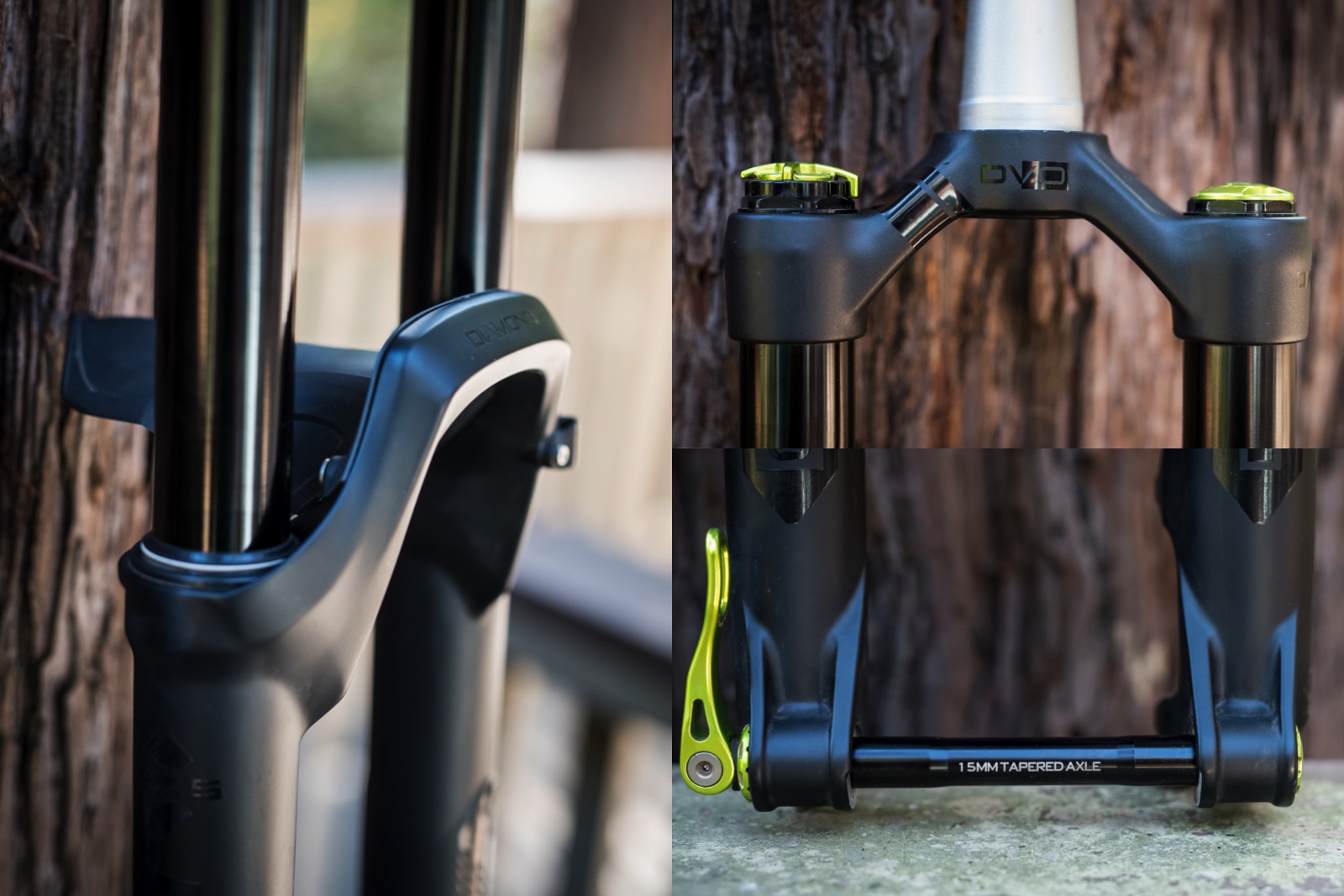
The quick release and axle are simple, clean and minimalist. A keyed T-Nut on the non drive side can be rotated to various positions so that the lever is oriented in the correct direction once secured. Last but not least – graphics…DVO hit the nail on the head in our opinion. This fork looks so damn good. The subdued mix of matte and glossy black anodizing looks clean and stealthy and the little pops of green anodizing on the small bits are subtle while still emphasizing their trademark branding.
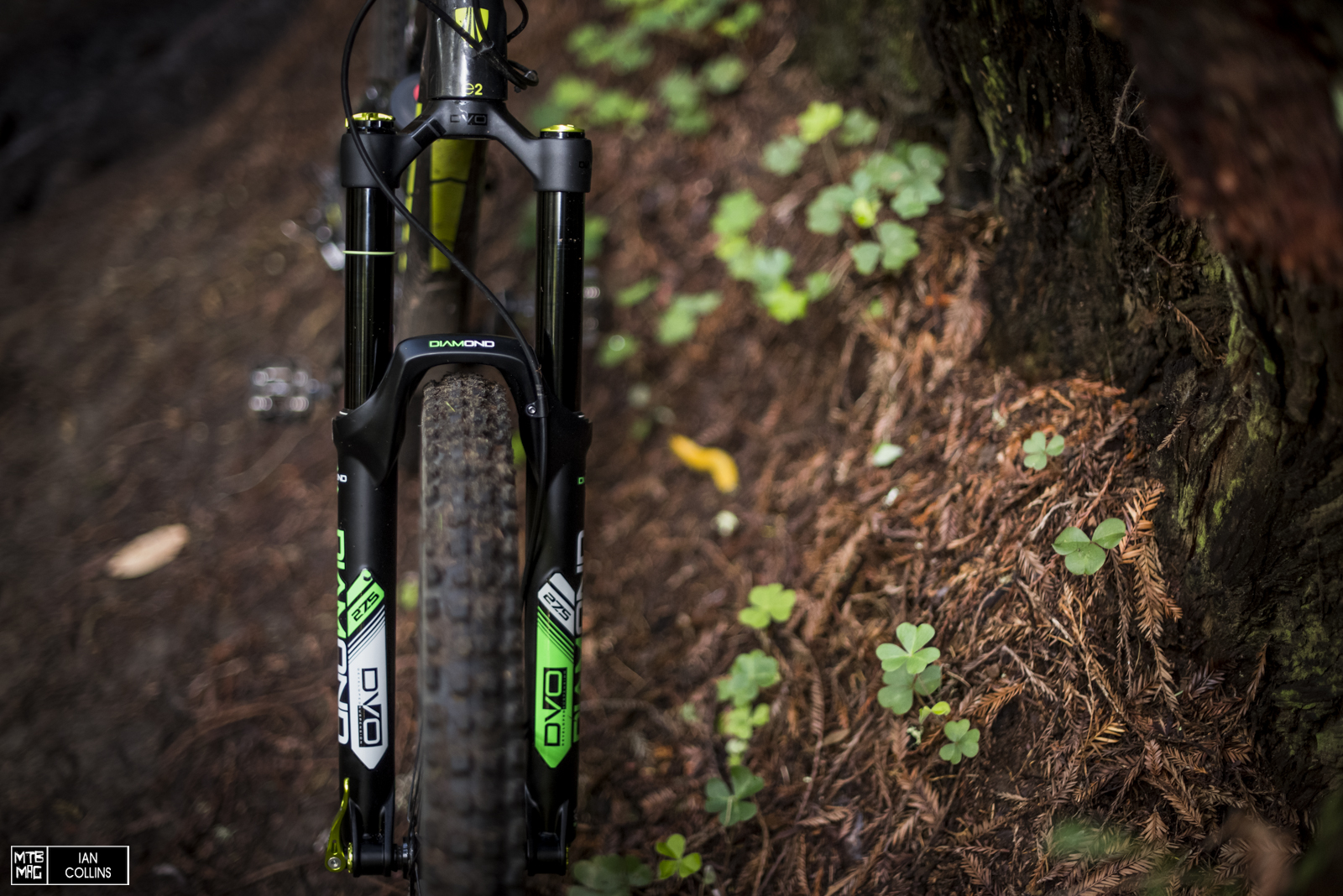
The graphics themselves look much better than the preproduction version we first received(shown above). For DVO superfans that want to buy color matching all Spank everything, they can buy the green fork and get right to it.
Setup
Per usual, for our very first ride we started precisely where DVO recommends on their setup page which, by the way – we feel they’ve done an excellent job with. Below is a chart with DVO’s base setting recommendations.

To sink in at just over 20% sag, our 185 pound rider started out with 125 PSI, 7 rotations of OTT, 10 clicks of rebound, 3 clicks of high speed compression and 2 clicks of low speed compression. It should be noted that the Diamond ships with 160mm of travel but you can use the two included 10mm spacers to set your Diamond up at 140mm or 150mm travel if you should so desire. That said, we always rode this fork on enduro bikes with 160mm (or close) rear travel and rather aggressive geometry/setup so we never dabbled with reducing our travel. Such bikes included : Trek Slash, Giant Reign, Norco Range and lastly we got a couple of rides aboard our new Evil Insurgent as well. Let’s see how the Diamond performed in the field.
Riding the Diamond
We may as well start from the beginning. As mentioned, we started out on a pre production version of the Diamond and graphics aside, it looked identical to the production version that we eventually jumped on. We had no qualms with our first fork and would have been just fine riding it all along, but after a some time DVO insisted we swap it out. Apparently there were some very minor, scattered QC issues but at 3 months into riding it we had zero issues. Anyhow, coming in at 2100 grams the Diamond is the heaviest fork in its category. To put it in perspective, it’s about a half pound heavier than a RockShox Pike or Fox 36. That said, it’s quite stout and has a very substantial feel. It also has more features and tuning options than the aforementioned forks.
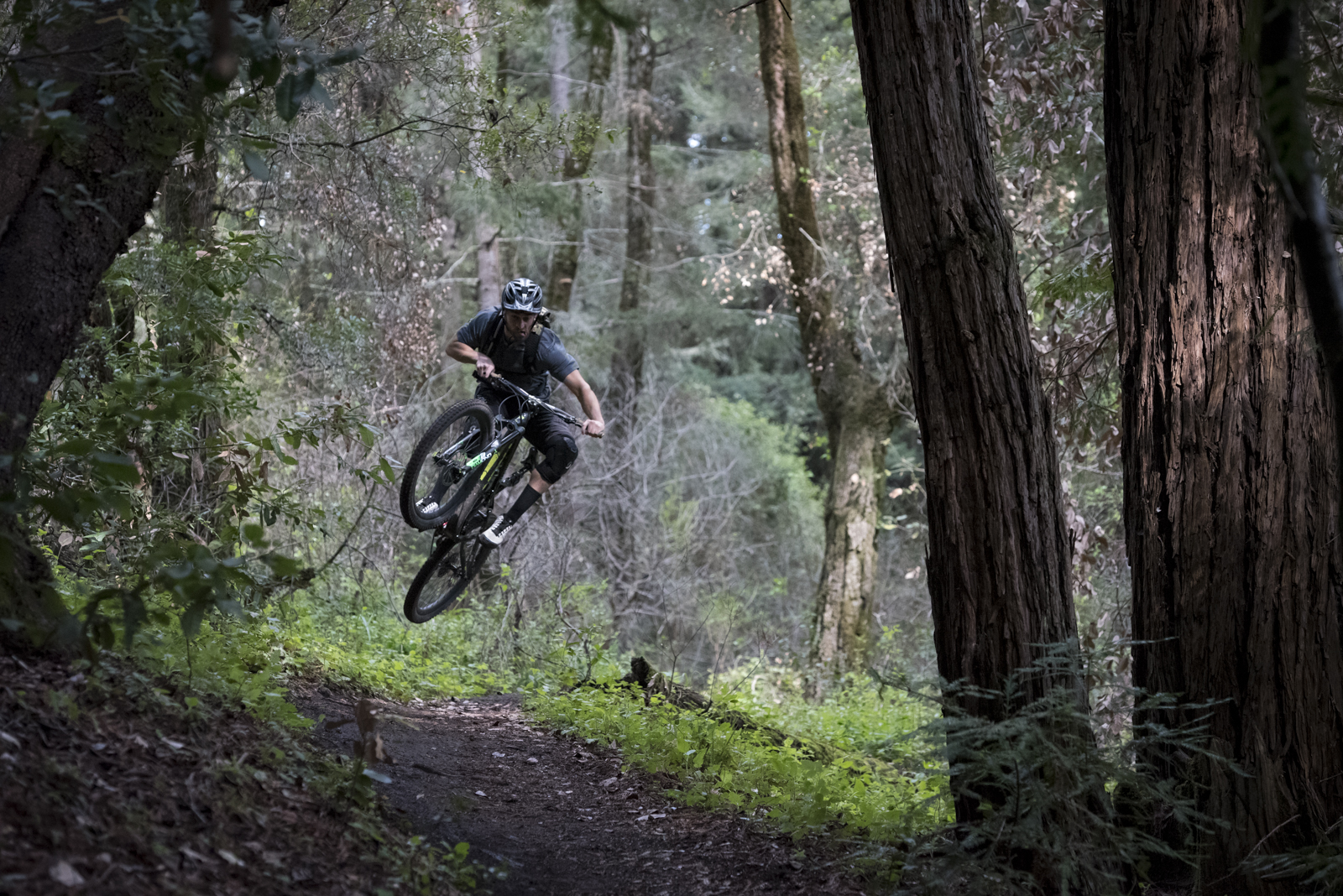
On our first ride we were blown away at the small bump compliance and incredible sensitivity. This fork required ZERO break in time. After we got comfortable and up to speed we realized we were using all of the travel a bit too easily and experiencing a bit of wallow in the turns as well as diving under heavy braking. No biggie, we’ll play with the OTT we thought. Bit by bit we dabbled with different variables and isolated our adjustments one at a time so we could really feel what each was doing. After toying with OTT for a bit, we found that it mainly was just true to its name and affected the very first bit of travel and did less than we expected to up the change the support in the middle of the stroke. We eventually felt it necessary to add some pressure and went up to 132PSI. That 7PSI difference turned out to be HUGE. At that point we didn’t use enough travel, the fork felt a bit harsh and we still didn’t quite have the mid stroke support we were looking for. We weren’t quite sure what else to do to find that sweet spot. Then it dawned on us to play with the spring curve…
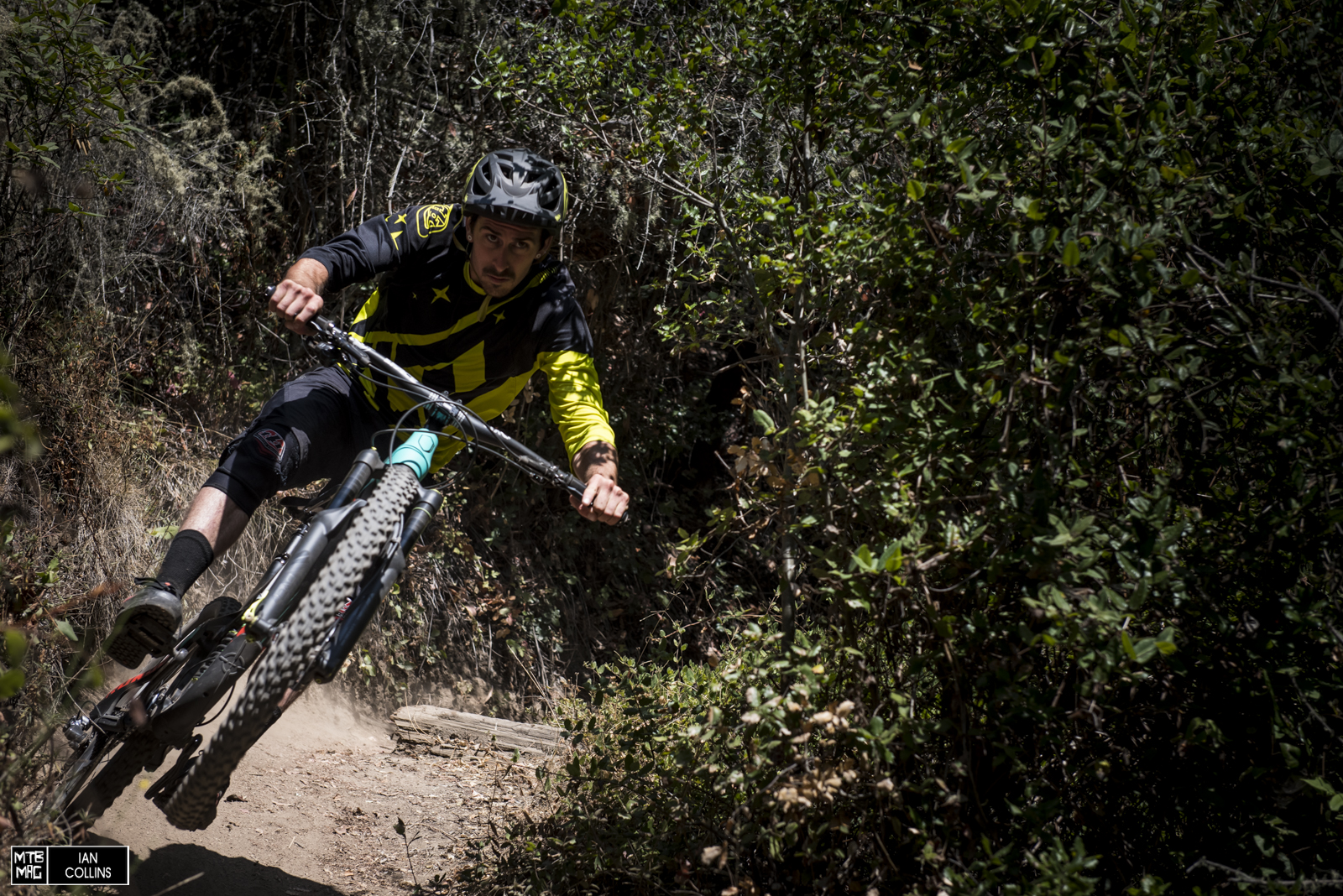
In a Pike or a 36 we can change the nature of the forks air spring from linear to progressive by incrementally adding volume reducers. The Diamond works accomplishes this differently but does so every bit as well albeit slightly less convenient. We chatted with Bryson Martin Jr. a bit and he told us to add 5CCs of fork fluid at a time by removing the core from the Schraeder valve that inflates the air spring. We started out with 15CCs and inserted it with an old brake bleeding syringe so we could measure the CCs accurately. Note: if you do this, clean the syringe properly first as even trace amounts of brake fluid could destroy your fork. Anyhow, lo and behold, upon reducing air volume we immediately found the mid stroke support we were looking for. The Diamond was lively and poppy on jumps and bonus lines. When we buried the front end into a turn it sat up in the travel and reduced dive brilliantly under heavy braking and on the lips of jumps. Despite dropping our pressure down towards the 128PSI range and reducing the OTT we still weren’t quite getting full travel. We took about 5CCs of oil out so it had about 10CCs left. Boom – that was our sweet spot. Light and sensitive off the top, supportive in the middle with a gentle ramp right at the end for the head slappers and G-outs. Perfect.
All things considered, while it’s a bit messier to dabble with the spring curve compared to other forks on the market, the benefit to using fluid is that you aren’t locked into 1, 2, or 3 reducers per se…you have infinite adjustment really.
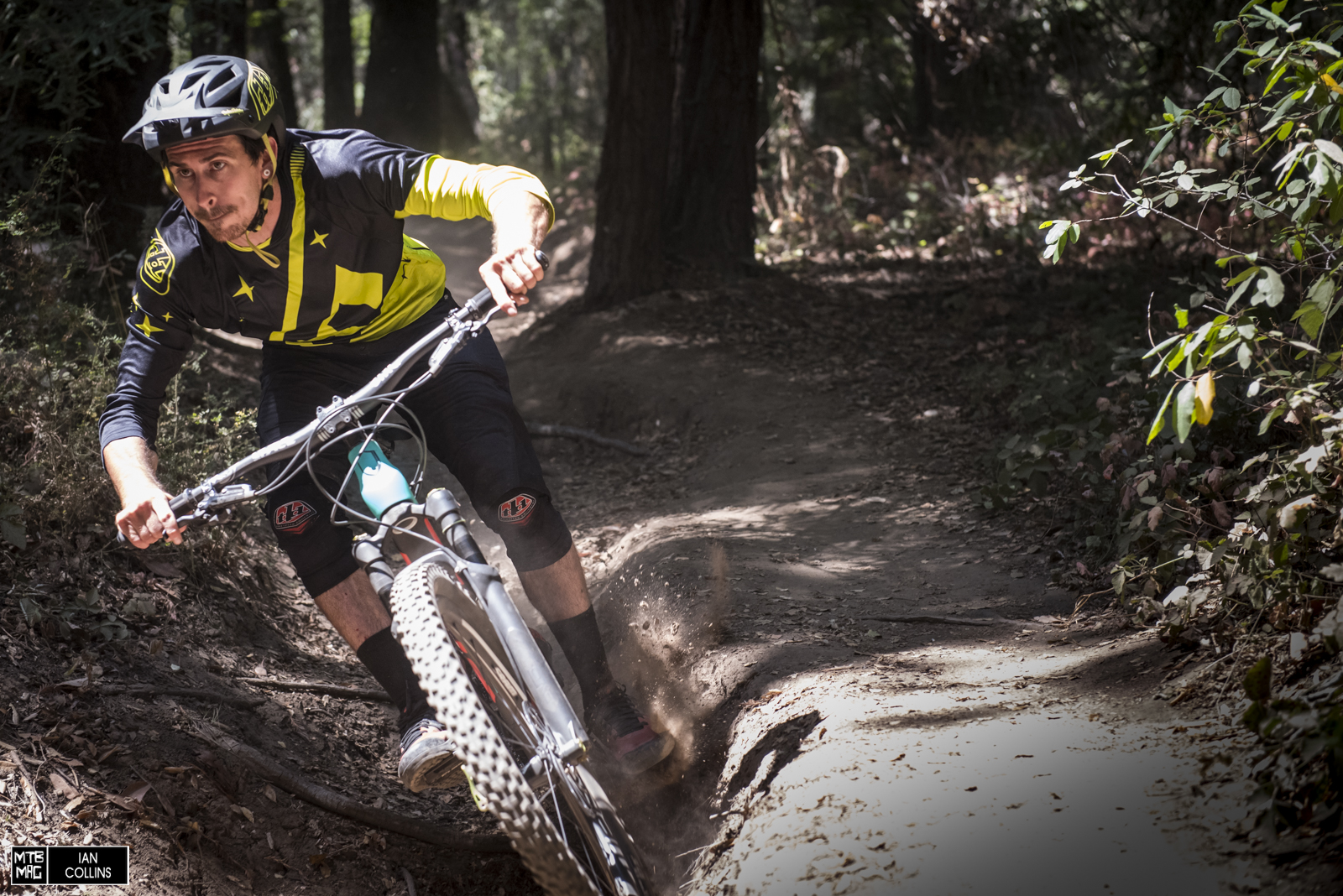
So, now that we found our sweet spot, we should talk about the chassis. With 35mm stanchions and a rather beefy construction, we just never even thought about stiffness whether in a rough chattery turn or under heavy braking. It was all an afterthought to be quite frank. With a Fox 36 being almost a bit too stiff and deflecting off some trailside obstacles and a RockShox Pike leaving us wishing for a bit more torsional rigidity in the gnarly stuff, the Diamond struck the perfect balance between the two and had just enough give without ever feeling flexy. We couldn’t be happier with how it felt no matter how hard we pushed it.
Our 27.5″ model features a 44mm offset. We wholeheartedly liked that. The RockShox Pike features a 42mm offset and the Fox 36 matches the DVO. When things got real fast and rowdy, we appreciated the added stability and we never felt that it steered sluggishly in the tight stuff, nor did it get floppy in the slow techy climbs. Really, we think 44mm is the magic number and would like to see more forks in this category using this number. It should be noted that the 29″ version sports a 51mm offset which is on the aggressive side of things as well. We’re currently riding a 29″ Pike with the same offset and loving it so that’s an indication that the 29″ Diamond will put a smile on your face just as well as it’s 27.5″ counterpart.
While we’ve pretty thoroughly covered the features and adjustments, we haven’t mentioned a lockout and that’s because the fork doesn’t really have one. This may sound like a breaker for some, but the low speed compression adjuster is easily accessible and on long fire road climbs we found ourselves flicking it to the firmest setting to settle the supple fork down a bit. For most of the rest of our endeavors we ran it at 2 or 3 out of 6 possible positions depending on how rowdy the terrain was. That was one of the few adjustments we found ourselves using a lot and we were quite happy at how easy it was to use on the fly. Much like the oil in the air spring, we liked having a bit more adjustment at our fingertips rather than being boxed into a climb, trail, descend type scenario.
Overall
So, where does the Diamond stand? First and foremost, hats off to DVO as they’ve come out swinging. Considering this is their second production fork ever and their first attempt at a mid duty fork, it’s an incredible product and we’re beyond impressed. With the combined years of expertise from Bryson Martin, his son, and a handful of ex Marzocchi employees, this should come as no surprise.
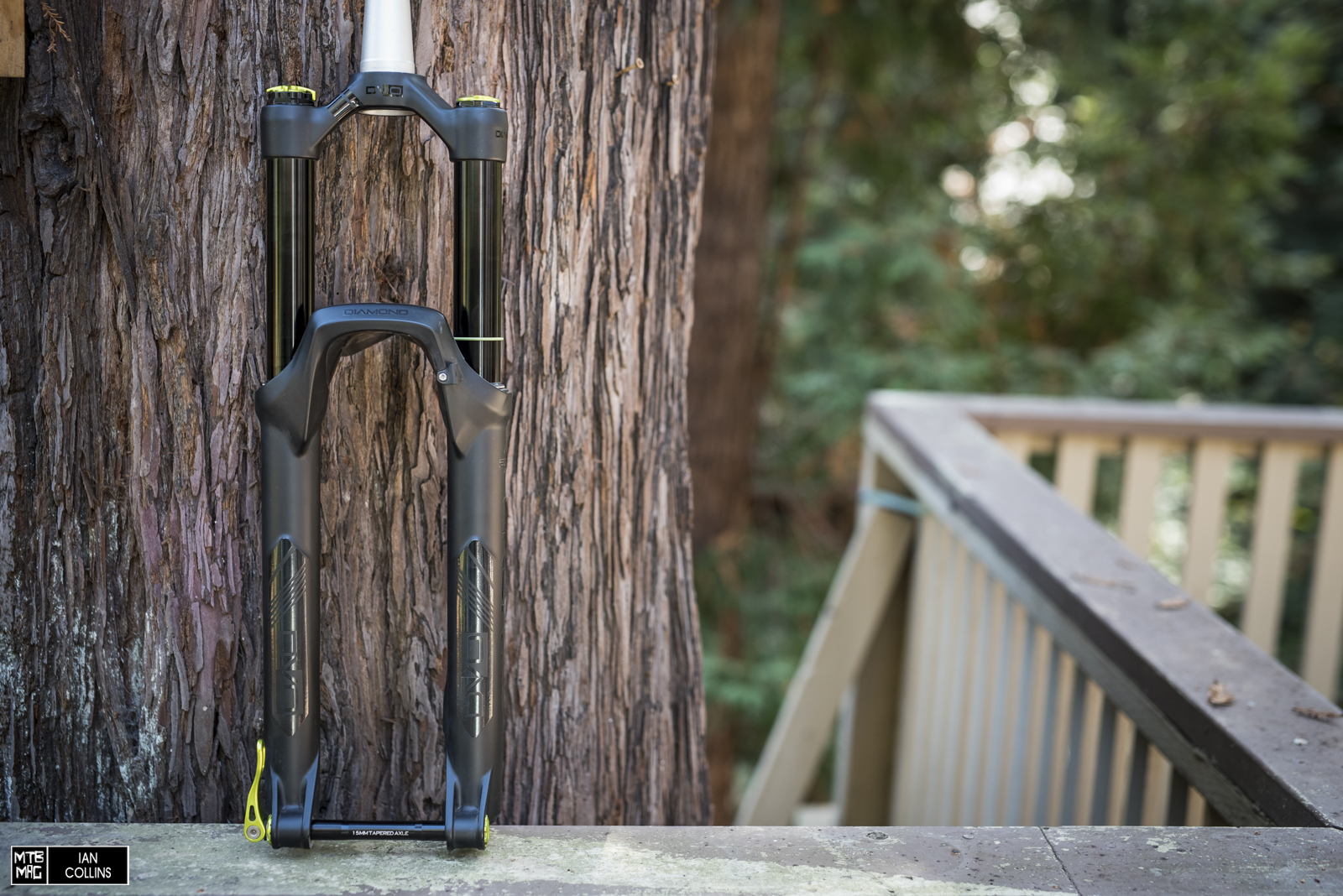
We feel confident recommending this fork to riders of any skill level. It’s bottom line performance is on par or better than the other big name offerings on the market with the only minor hindrance being the weight. You don’t feel it much on the trail, but as we all know it does add up. The price is on par with other high end offerings but what really makes it stand out is the massive range of adjustment and set up options. If you’re a novice rider, you can set the fork up perfectly for your weight and ability. On the opposite end of the spectrum, if you’re a seasoned rider smashing in the park, you can set it up aggressively as well.
That said, you will have to be patient and do some homework as there is just a bit of a learning curve to figuring it all out; understandably so as the fork has an absurd amount of range. DVO has done an excellent job with everything from articulating basic suspension terminology to full breakdowns of how to rebuild their products and everything in between. Setup, service guides and tuning instructions can all be found on their website in king’s english.
One other thing that we haven’t touched on is the ability to easily experiment with custom shim stack configurations right at home. DVO has gone to great lengths to incorporate this option into the design of all of their products via the “Top Loader”. They have literally left no stone unturned. The Diamond gets our highest praise for its sensitive buttery feel, wide setup range and well tuned chassis. We look forward to seeing more exciting products from DVO’s camp in the future.
DVO Suspension
[ad45]

